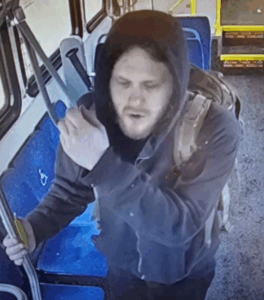


The brutal murder of 19-year-old Sade Robinson after what should have been an ordinary first date has become a catalyst for sweeping changes in how law enforcement handles missing Black women cases across the United States.
Sade Robinson embodied hope and determination. The Milwaukee Area Technical College student was pursuing criminal justice with aspirations of military service, balancing her studies with work at Pizza Shuttle while maintaining the infectious smile and fierce work ethic that defined her character.
On April 1, 2024, Robinson was excited about her first date with Maxwell Anderson, a 34-year-old man she’d met while socializing with friends. The evening began innocuously at the Twisted Fisherman restaurant in Milwaukee’s Menomonee Valley, followed by drinks at Dukes on Water. However, this routine first date would become Robinson’s last night alive.
When Robinson failed to appear for work the following day, her concerned coworkers contacted police to report her missing. Yet her mother, Sheena Scarbrough, wouldn’t receive notification for another 48 hours—a delay that would later fuel her advocacy for systemic reform in missing persons protocols.
The grim reality of Robinson’s fate began unfolding on April 2, 2024, when her severed leg—toes still painted with pink polish—was discovered on the shores of Lake Michigan at Cudahy’s Warnimont Park. Her dismembered remains would eventually be found scattered across Milwaukee County, though her head has never been recovered.
Simultaneously, Robinson’s car was discovered burned on Milwaukee’s north side, while surveillance footage captured Anderson boarding a public transit bus shortly after the vehicle fire. These digital breadcrumbs would prove crucial in the investigation that followed.
During the two-week trial that concluded with Anderson’s conviction on Friday, prosecutors presented disturbing evidence of premeditation. Milwaukee County Assistant District Attorney Ian Vance-Curzan told jurors that Anderson “brutally and callously” killed and dismembered Robinson, revealing a horrific crime that shocked even seasoned investigators.
The prosecution’s case relied heavily on digital evidence, including license plate readers, surveillance footage, and cell phone tracking data that traced Robinson’s movements from the initial dinner date to Anderson’s south-side residence. Video evidence showed “on-and-off” movement at Anderson’s home throughout the night of April 1 until 12:45 a.m. on April 2.
Perhaps most damning was testimony from a confidential informant who revealed that Anderson had planned Robinson’s murder weeks in advance. According to court filings, the informant visited Anderson’s home on March 5, where Anderson showed off his basement preparation—complete with plastic tarps covering a sanitation sink, walls, floor, and ceiling, along with three saws.
The informant testified that Anderson explicitly stated his intention to kill Robinson, describing in detail how he planned to force her into the basement, shoot her, dismember her body, and dispose of the remains throughout the city. This premeditation transformed what might have appeared as a crime of passion into something far more sinister.

Robinson’s murder highlighted a stark and troubling reality: Black women face disproportionate levels of violence in America. According to a 2024 Columbia University report, Black women in Wisconsin are 20 times more likely to be murdered than their white counterparts—a statistic that Scarbrough was painfully aware of when she insisted on phone tracking between herself and her daughters for safety purposes.
The case represents one of 34 domestic violence homicides in Milwaukee during 2024, with nine occurring in the current year alone, according to data from the Sojourner Family Peace Center. These numbers reflect a national crisis that has historically received insufficient attention from law enforcement and media outlets.
Robinson’s case also illustrates the “missing white woman syndrome”—a phenomenon where cases involving white victims receive disproportionate media coverage and law enforcement resources compared to cases involving Black women and other women of color. This disparity often results in delayed responses that can prove fatal in time-sensitive situations.
Rather than allowing grief to consume her, Scarbrough channeled her pain into purposeful action. Recognizing that her daughter’s death could prevent future tragedies, she established Sade’s Voice Foundation, a nonprofit organization dedicated to protecting young people and supporting families navigating similar unthinkable circumstances.
“For all of the other missing and murdered Black, indigenous people of color,” Scarbrough explained when describing her foundation’s mission. The organization focuses on addressing systemic gaps in missing persons protocols while providing support networks for affected families.
The foundation’s work extends beyond awareness campaigns to include practical advocacy for policy changes that could save lives. Scarbrough’s efforts have already begun yielding results, with legislative partnerships forming across multiple states to address inadequacies in current missing persons procedures.
Robinson’s case has energized lawmakers across the country to introduce comprehensive reforms addressing the unique challenges faced by missing Black women cases. Wisconsin State Representative Shelia Stubbs has pledged to reintroduce legislation strengthening police response protocols for missing persons, with particular emphasis on Black women and girls.
The proposed Wisconsin legislation would address several critical gaps identified in Robinson’s case:
Mandatory Notification Timelines: Establishing requirements for immediate family notification when missing persons reports are filed, eliminating the 48-hour delay Scarbrough experienced.
Enhanced Investigation Protocols: Creating standardized procedures that prioritize cases involving demographic groups at higher risk of violence.
Training Requirements: Mandating cultural competency and implicit bias training for law enforcement officers handling missing persons cases.
Resource Allocation: Ensuring adequate investigative resources are allocated regardless of the victim’s race or socioeconomic status.
Beyond Wisconsin, the reform movement is gaining traction nationwide. Massachusetts Representative Bud Williams has introduced legislation creating a statewide task force focused on improving law enforcement responses to missing Black women cases. This initiative would establish dedicated protocols, training programs, and resource allocation specifically designed to address historical disparities in case handling.
Several states have already implemented similar reforms with varying degrees of success. Minnesota, California, New York, and Illinois have established specialized units or task forces dedicated to missing persons cases involving Black women and other underrepresented communities.
These initiatives have produced measurable improvements in response times, case clearance rates, and family communication protocols. However, implementation remains inconsistent, and many states, including Wisconsin, have yet to pass comprehensive legislation addressing these issues.
Organizations like the Black and Missing Foundation Inc. and Our Black Girls have played instrumental roles in amplifying underreported cases and advocating for systemic changes. These groups provide crucial support services while working to eliminate the disparities that contributed to cases like Robinson’s receiving delayed attention.
Robinson’s murder occurs within a broader context of violence against Black women that demands urgent attention. Research consistently demonstrates that Black women experience intimate partner violence at rates 35% higher than white women, yet their cases often receive less media attention and fewer investigative resources.
This disparity extends beyond individual cases to systemic issues including:
Stereotyping and Bias: Harmful stereotypes about Black women can influence how law enforcement and media outlets perceive and prioritize cases.
Economic Factors: Limited financial resources may restrict families’ ability to maintain public pressure for investigations.
Historical Mistrust: Legacy issues between Black communities and law enforcement can impede cooperation and information sharing.
Intersectionality: The intersection of race and gender creates unique vulnerabilities that traditional approaches may not adequately address.

Robinson’s case demonstrated both the potential and limitations of technology in missing persons investigations. The Life360 app, which allowed Robinson’s friend to track her location, provided crucial evidence that helped establish the timeline and identify key locations.
However, the case also highlighted how technology can be manipulated by perpetrators. Prosecutors revealed that Anderson attempted to cover up the crime using text messages, illustrating how digital communication can be weaponized to mislead investigators and delay responses.
Modern missing persons investigations increasingly rely on digital evidence including:
Location Tracking: GPS data from phones and vehicles can provide crucial timeline information.
Social Media Analysis: Digital footprints often reveal important context about relationships and activities.
Surveillance Networks: Expanding camera networks provide unprecedented investigative opportunities.
Communication Records: Phone and messaging data can establish patterns and reveal concerning behaviors.
The Milwaukee community’s response to Robinson’s murder has been profound and sustained. Her posthumous graduation from Milwaukee Area Technical College, where her sister Adriana accepted her criminal justice degree, became a powerful symbol of dreams deferred but not forgotten.
Community organizations have rallied around Scarbrough’s advocacy efforts, recognizing that Robinson’s case represents broader systemic failures that require collective action. Local activists have organized awareness campaigns, safety workshops, and policy advocacy sessions aimed at preventing similar tragedies.
The case has also sparked important conversations about dating safety, particularly for young Black women who face unique risks in social situations. Community leaders have developed educational programs addressing personal safety strategies while working to address the underlying societal factors that create these dangers.
As Anderson faces life imprisonment for his conviction on charges of first-degree intentional homicide, mutilating a corpse, hiding a corpse, and arson, Scarbrough continues her advocacy work with unwavering determination. She views her daughter’s legacy through the lens of the lives that can still be saved through systemic reform.
“She has saved so many young women and individuals. My baby is a hero,” Scarbrough reflected, emphasizing how Robinson’s death has already begun protecting others through increased awareness and policy changes.
The foundation’s work continues expanding, with partnerships forming across multiple states to implement comprehensive reforms. These efforts focus on practical changes that can immediately improve outcomes for missing Black women while working toward longer-term cultural shifts that address underlying inequities.

Call to Action for Systemic Change
Robinson’s case demonstrates that individual tragedies can catalyze systemic change when channeled through effective advocacy. However, lasting reform requires sustained effort from multiple stakeholders:
Law Enforcement Agencies: Must implement comprehensive training programs addressing implicit bias and cultural competency while establishing standardized protocols for missing persons cases.
Legislative Bodies: Should prioritize passing comprehensive reform legislation that addresses documented disparities in case handling and resource allocation.
Community Organizations: Can continue amplifying underreported cases while providing crucial support services for affected families.
Media Outlets: Should examine their coverage patterns to ensure equitable attention for missing persons cases regardless of victim demographics.
Educational Institutions: Can integrate discussions about violence against Black women into curricula while supporting research that informs evidence-based policy solutions.
The transformation of Robinson’s tragedy into a force for positive change demonstrates the power of advocacy in addressing systemic injustices. As Scarbrough noted, “She had such a light, and even now, I believe that light’s still working.”
Through continued advocacy, legislative reform, and community engagement, Robinson’s legacy will extend far beyond her own story to protect countless other young women who deserve the same chance at life, safety, and fulfillment that was tragically stolen from her.
The fight for justice in missing Black women cases has found its voice in Sade Robinson’s story—a voice that demands to be heard until real, lasting change transforms how society protects its most vulnerable members.
